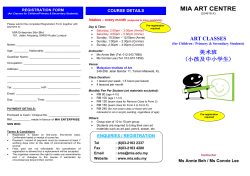
Face Painting - Getting Started Getting ready to paint
Face Painting - Getting Started Getting ready to paint You will need: Water based face paint – won’t harm most skin, but test for allergies (see Health and Safety). Old plate or saucer for mixing paint. Brushes at least one thick (size 6), thin (size 2) and a medium flat–ended brush. Make-up sponges or bath sponge cut into pieces (at least 2 or 3). Cotton buds for applying spots of colour. Wear old clothes, so it doesn’t matter if you get paint on them (although it does wash off). A tub of water for cleaning your brushes. A mirror for children to see the results. A towel for covering the models clothes around the shoulders. Paper towels, tissues and baby wipes for wiping hands. Face wipes to removing face paint. Face painting book – useful for ideas. Sketch 3 or 4 faces to provide children with a range of options from which they can choose. Sit close, facing the child and position your knees outside theirs. Bring the child forward and let them rest their hands on your knees for steadiness. It is important that both of you are sitting comfortably. Keep your hands clean and dry and make sure the child’s face is clean and dry before starting to paint. Provide all face painters with their own palette of face paints and brushes. Place paint, water and brushes on table near your painting hand. Clip back any hair that falls over the face. Place your free hand lightly on the child's head to keep it steady and allow you to move it from side to side when painting. Have a bowl of soapy water to clean brushes between faces. Health and Safety 1. Always ask permission from a parents or guardian before painting a child's face. 2. Never paint a child's face under 3 years or a child’s face unless they are happy to have it done. 3. If unsure about allergies do a test patch on the inner elbow crease. Leave it for 1 hour and if the child appears to react to the face paint then wash it off immediately with a face cloth and warm water. 4. Never paint a child’s face with a skin complaint or a cold sore. As an alternative paint arms, hands or feet. 5. Inform the child of what you are doing to help prevent any sudden movements. Take care when using a paint brush near the child's eyes. 6. Don’t paint in a crowded area where there could be a danger of someone bumping into your arm whilst painting. 7. Ask children to close their eyes when painting around or on their eye lids. 8. Don’t rub or paint the face too hard. 9. Use short handled paint brushes. 10.Steep brushes and sponges in Detox to sterilise them. www.playresource.org - Face Painting Getting Started Face Painting - Designs For the base coat wet a sponge and squeeze it hard before rubbing it lightly in circles over the paint. Apply the paint evenly over the face dabbing the sponge onto the face with a twist of the wrist (not long continuous strokes). If the paint streaks it is too wet. Work carefully and gently around the eye area. When painting the detail dip the brush into water and roll it around in the face paint, continue to do this until you have a watery paint puddle. Hold the brush like a pencil and rest your little finger on the child's face to keep a steady hand. Add detail from the top d own, eyebrows and mouth last although if you have paint on your brush it’s a good idea to use it where it is needed. For example, do all the red parts first and so on to avoid rinsing the brush too often. Load the brush with paint and dab the brush to make detail such as petals. Paint with the brush at right angles to the face. Animals - black nose split upper lip and whiskers will suggest the features of many animals. Always sponge the middle of a cat face a lighter shade than the outside to produce a muzzle effect. Look at animal features and develop your own designs, avoid too much detail. White streaks next to black whiskers help them stand out. Details - lay the bristles flat on the face and draw the brush along to achieve a thick continuous line, use the tip to produce a fine lines. Use cotton buds to do fine spots. Stippling – dab a dry or just damp sponge into the face. This is good for beards and stubble. Blending – try blending colours on the face for example creating green from blending yellow and blue. Wash the brush before going onto the next colour. You can paint one colour on top of another but wait until the first is dry. Scary Faces - paint monsters witches vampires and skeletons for Halloween. Start with creepy base such as white, green, yellow or mauve and paint the brow bone with a contrasting shade, sponge down the side of the nose and shade hollows in under the cheek bones to look scary. Ideas - look for inspiration for your designs from face painting books. www.playresource.org - Face Painting Designs
© Copyright 2025





















